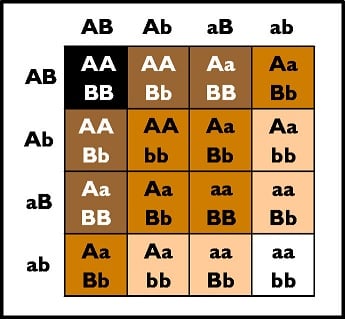Free Bible Commentary
“Where Did All The Differences Come From?”
Categories: GenesisInstead of reading further in Genesis chapter 11 today I thought we would take a detour and consider some interesting information concerning the differences that exist among the people of the world. We know where the different languages came from, but where did all the different colors come from? There is one major pigment, called melanin That produces skin color. There are two main forms of melanin: Eumelanin (brown to black) and pheomelanin (red to yellow). These combine to give each of us our particular skin shade. There are four to six genes, each with multiple alleles (or variations), that control the amount and type of melanin produced. These variations account for all the wide varieties of skin coloration. It is easy, therefore, for one couple to produce a wide range of skin shades in just one generation.
DNA is the molecule of heredity that is passed from parents to children. In humans, the child inherits 23 chromosomes from each parent. At conception, these chromosomes unite to form a unique combination of DNA and a unique individual. Each chromosome pair contains hundreds of genes which regulate the physical development of a child. No new genetic information is generated at conception, just a new combination of pre-existing genetic information is formed.
A simplified illustration is given by an Apologetics Press article entitled Reason and Revelation. Included is a Punnett Square demonstrating how two genes would control melanin production. This is just for illustrative purposes. In the “AB” versions the genes code for a significant amount of melanin. In the “ab” versions they code for a small amount of melanin. If the mother and father both carry the “AB” code then their offspring would be "AABB" giving them a lot of melanin and very dark skin. If the mother and father both carry the “ab” code their children would be “aabb” having a little melanin and very light skin. If the father is “AB” and the mother is “ab” the offspring will be "AaBb", with a middle brown shade of skin, which the majority of the world’s population possesses. If each parent has the “AaBb” gene combination they could produce and account for a wide variety colors in just one generation.
It is only logical to deduce that Noah and his family had middle brown skin pigment, which would account for all the skin color variations in the whole world. No one really has red, yellow, or black skin. We all have the same basic color, just different shades of it. We all share the same pigments, our bodies just have different combinations of them. The so-called major differences (skin/hair color, eye shape, etc.) account for only 0.012 % of our biological variations, which anyone would agree is trivial.
So what accounts for the origin of people groups with concentrations of similar physical features & skin colors? Because of the new language and geographic barriers from the confusion and dispersion at Babel, groups didn’t mix freely with other groups, resulting in a gene pool split. Different cultures formed, with certain features becoming predominant within each group. Some of these combinations became general characteristics of particular groups through selection pressures and gene mutation. The characteristics of each became more and more prominent as new generations of children were born.
As an example: Generally speaking, those with darker skin tend to derive from warmer climates, and lighter skinned people tend to derive from colder climates. Because of the protective factor in melanin, those with dark skin are more likely to survive and thrive in climates with intense heat and sunlight, and are less likely to acquire skin cancer. Those with lighter skin and less protection from UV rays are less likely to proliferate and subsequently their numbers are fewer. On the downside, melanin is a natural sun blocker which limits the sunlight’s ability to stimulate the liver to produce vitamin D, which in turn builds strong bones. Dark skinned people do not do as well in northern, colder regions that have less sunlight. People deficient in vitamin D are more likely to develop diseases such as rickets which is associated with calcium deficiency causing slowed bone growth and easy fracturing.
Those with darker skin in England during the Industrial Revolution were quick to develop rickets for the lack of sunlight. An exception to this trend is darker-skinned Inuit tribes living in cold northern regions. Not surprisingly their diet consists of mostly of fish, and fish oil is a good source of vitamin D, which could account for their survival in this area. I’m not saying these are the answers, but that they could possibly explain some things, and that there are good explanations for these difficult questions, that completely harmonize with the biblical account of Creation, the Flood, the confusing of the languages, and all other Bible narratives.
Please read Genesis 11:10-26 for tomorrow.
Have a great day!





